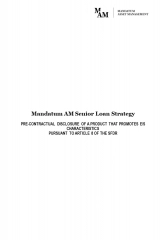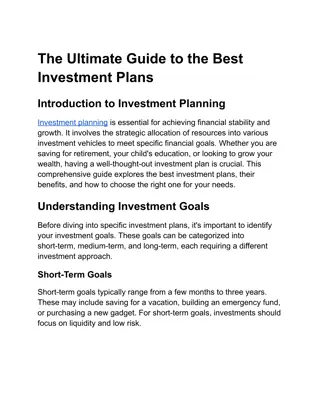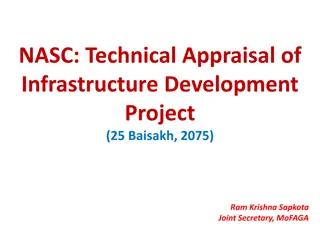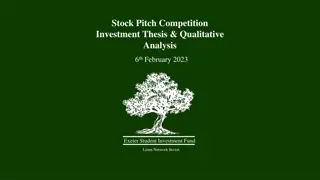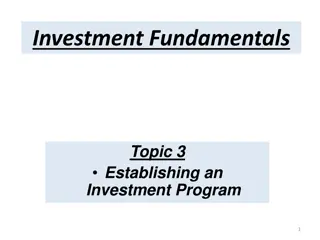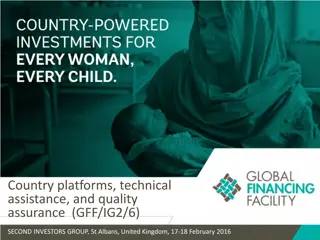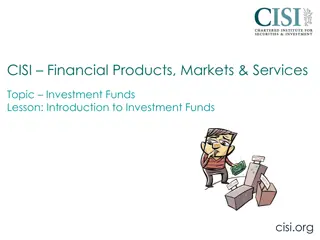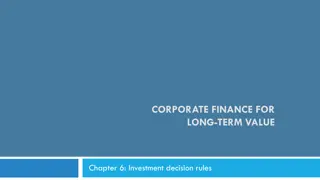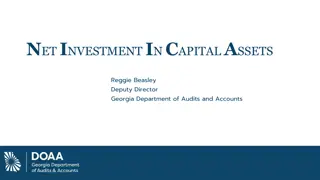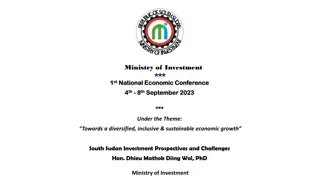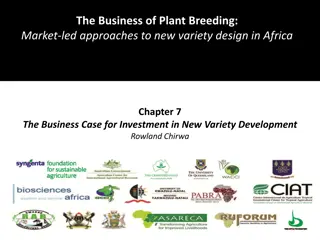Public Investment Review and Development Analysis at PSDP 2019-20
Delve into the key themes of the Public Sector Development Programme (PSDP) for 2019-20, emphasizing the focus on growing a knowledge economy, boosting agriculture, and aligning with global imperatives. Explore the role of public policy, investments, and the state as a change agent in driving economic development and innovation. Uncover the challenges and considerations in decision-making around investments and allocations in the development landscape.
Download Presentation

Please find below an Image/Link to download the presentation.
The content on the website is provided AS IS for your information and personal use only. It may not be sold, licensed, or shared on other websites without obtaining consent from the author.If you encounter any issues during the download, it is possible that the publisher has removed the file from their server.
You are allowed to download the files provided on this website for personal or commercial use, subject to the condition that they are used lawfully. All files are the property of their respective owners.
The content on the website is provided AS IS for your information and personal use only. It may not be sold, licensed, or shared on other websites without obtaining consent from the author.
E N D
Presentation Transcript
Reviewing the Public Investment; PSDP 2019-20 Doing Development Better; Analysing the PSDP. PIDE Conference: Planning Commission February 27, 2020 Dr. Shaukat Hameed Khan
Basic Themes of the PSDP Emphasis on building knowledge economy on the world technology map. New projects in the field of IT, S&T, education, industry and agriculture would be initiated during financial year 2019-20 which would give desired direction to the economy. SPECIAL ATTENTION TO AGRICULTURE GROWTH. Crop maximization, Improvement in livestock, fisheries, Efficient irrigation system and improvement of watercourses. & CPEC
The Global Imperatives and Public Policy. The State as Agent of Change Emerging morphology of the global economy, distinctive features: Transnational / Vertical Division of labour, Diffusion of work, technology & ownership caused by machine / dig. innovations and computerization; .requires matching of transnational skills. i. Pascal Lamy: an irrevocable shift of manufacturing from the 1970s to 90s from developed to developing countries ii. Designing too can now be undertaken almost anywhere. Almost alldeveloped economies can now be identifiedas knowledge economies to some extent or the other, Taking further steps to consolidate this position by becoming even more knowledge intensive and competitive. Even when their productivity growth has slowed down, the rate of increase in their skill bias in technology has not.
The Global Imperatives and Public Policy. The State as Agent of Change Other intrinsic factors: Development of institutional excellence andfast-moving human resources, + strategic alliances for complementary resources. Developing countries also witnessing a sharp reductionin relative demand for unskilled labour since the end of the 1970s. In all these emerging economies, public policy and investment has played the major role. In some newly industrialized Asian countries, Govt. Policies and Activities; >> SMEs evolved into major global players /conglomerates. These now offer complete end-to-end services in the supply chain, whether as manufacturers of piece parts and systems, or providers of services, design and research.
National Development Programme, 2019-20 Total : Rs 1,863 b: (Prov. Rs 912 b + Fed. PSDP: Rs 951 b) Foreign Assistance: Rs 128 b; and in view of shrinking public resources + Rs 250 b through innovative financing. 18 Share (%) of Federal PSDP 2019-20 16.2 16 14 12 10 9 8 6 4.7 4.5 4.2 3.9 3.4 3.1 4 1.3 1.4 1.7 2 0.8 0.8 0.5 0
Issues in Deciding Investments / Allocations Overlaps > Repetitions > Monitoring > Jurisdictions Wrong Costing, Value, Impact, ? CDWP vs DDWP Many times only get buzz-words for excitation ? Current Fashion is for knowledge Economy, IoT, AI Competence in Evaluation and Monitoring Federal / Provincial Love Affair CPEC is the latest complication News Item ML - 1 Rail project may be on BOT basis. Any Foresight Exercise: Determine Need, Value, & Impact
Its the Skills, Current And Future Example: Exports Forget Energy Costs. We do not make what the world market wants and of course Quality, Standards & Reproducibility Skills. Skill. Skills. 34 % of workforce has <8 y of schooling; 44% <1 year. CANNOT EVEN MAINTAIN OUR INFRASRUCTURE The skilled technician is more valuable than a PhD We have not leveraged the CPEC / BRI programs Our young men are not employable. The Government is No Longer an Agent of Change Pakistan is facing risk of rapid de-industrialization !
Pakistan & Evolution of Global Education Systems & Evolution of Global Education Systems Study of Study of 149 Countries, 1950 149 Countries, 1950- -1991 Comparing Vocational vs General Enrollments in Secondary Education. (Bertoochhi & Spagat, 2002) 1991, 0.7 Avg. Voc./ General Enrolment Avg. Voc./ General Enrolment 0.6 0.5 0.4 0.3 Pakistan Pakistan Should be here Should be here 0.2 0.1 Pakistan Is here Pakistan Is here 0 1 2 3 4 5 6 7 8 9 10 11 12 13 14 15 16 17 18 Classes of per Capita GDP, in USD x 1000 Classes of per Capita GDP, in USD x 1000 Measure of the Degree of Stratification of the Society. Reflects the Complex Interaction Between Econ.and Political Forces, (aggregate income growth, wealth inequality, political participation) 8
The Low Skills, Low Productivity, Low Expectations Trap The Low Skills, Low Productivity, Low Expectations Trap The knowledge worker is not necessarily a PhD. 12-17 Age Group Pakistan Illiterates Less than 8 school years 32 % 1% 1% 1% Formal Skills Enrolment 3 % (0.3 m) 45 % 30 % 23 % University Enrolment 1.6 m 44% 1% 1% 1% Turkey Iran Malaysia Ref: UNESCO and FBS, 2018 Irish Workforce: Educational Attainments (%) Education Levels 1972 Primary Secondary Hi. Secondary Tertiary Ultimately Its all about Productivity / Worker 1982 36 24 24 16 1992 22 28 29 21 2002 8 28 28 35 50 21 20 9
Formal TVE Enrolments, 2016 5,000 4,000 3,000 2,000 X 1,000 - 2500 Other TVE Enrolments 2012 2013 2270 2086 2000 2014 2015 2016 1395 1500 X 1000 1321 1109 794 832 1000 602 336 367 337 500 0 0 Country Data Labels for latest year only
Demographics and Education Numbers, Millions with By 2050: Must aim for at least 30% enrollment which are certifiable / recognised internationally. 160 education 5 14 years 140 < 5 y < 8 y < 10 y < 12 y > 12 y > 14 y Illiterate 134 120 Literate 100 80 83 m 60 40 13 39 13 20 Will encourage inclusive growth 26 26 16 0 THIS WILL ALSO MAKE PEOPLE EMPLOYABLE
Table 1:Technological Readiness & Innovation, Selected Countries Best Worst Pakistan 114 Turkey 53 Malaysia 40 Ireland 23 India 24 Overall Global Rank, from 137 9th Pillar: Technological Readiness 111 62 46 18 107 70 88 69 124 107 57 36 61 70 59 35 17 13 32 75 33 21 1 24 28 72 73 59 100 105 Availability of latest technology Firm-level technology absorption FDI & technology transfer Individuals using Internet, % Fixed BB Internet subscribers, % 119 60 26 22 124 Int. Internet B/W, kb/s per user 12th pillar: Innovation Capacity for innovation Quality of Scie. Research Institutes Company R&D 60 80 67 52 69 74 100 69 22 14 24 15 19 19 19 20 29 42 35 23 63 66 11 13 26 Univ./Industry R&D Collaboration 33 64 4 60 8 Govt. proc. of adv. tech. products 63 49 7 21 32 Availability of Scientists & Engineers 105 39 40 19 63 PCT Patents , application/million
Just love the world National HEC Many National Centers National Centers of (259) Excellence in Big data/Cloud computing (Rs 1.5 b) [ 3/2018 ] (260) Excellence in cyber Security (261) Robotics and Automation (299) Artificial Intelligence (Rs 1.1 b) (358) GIS and Space Applications (359) Nano Science & Nano technology (Rs 1.5 b) Must have critical Mass of researchers before naming them National (Rs 1.2 b) (Rs 1.3 b) [ 3/2018 ] [ 3/2018 ] [ 5/2017 ] (Rs 1.0 b) [ 3/2018 ] [ 3/2018 ] Activity Overlap ? NTRC ( All DDWP), [ cost Rs m, and dates ] (041 - 045) Accident Data & Cost Study, 58 m, [01/18] ; Axial Load Survey, 44 m, [09/17]; Ops Research, 44.4 m, [09/17 ]; Origin Destination Survey & Tpt. Demand, 57.0 m, [09/17]; Permanent Traffic Count Program, 57.7 m, [09/17] NEW : No 46, Study of Freight Tpt. Trucking in Pakistan, DDWP, 58.0m [04/2019]
Repetition? Monitoring ? Repetition of project done 11-12 years ago (429) Product Dev. Center for Comp. Based Sports Goods , Rs 488 m, [10/2017] (451) E-Office Replacement at all Divns of Fed. Govt., Rs 0.44 m, [03/2018 ] Problem with Institutional Memory ? Love This One Pakistani Rugged Tripods had ~12-13 % of the EU Market, 2018 Hi-tech lasers exported to Malaysia, Bangladesh, Germany, Switzerland, some costing US$ 230,000/- each. Laser & Optronics Production in Pakistan Exceeds Rs 28 b
4000 units sold in Pakistan, 31%-37% Less Water Uniform Fert. Intake Yield: Up by 16-18% because of uniform distribution of water and fertiliser. Detector Position Monitoring System. 40 Lasers system installed in CMS at CERN, Geneva. The only Pakistani designed and manufactured item from Pakistan.
Energy: Industrial Opportunity (15 y) ~ US$ 230 250 bn; HW + SW +Infrastructure Some within existing Capability ( ~ 20 %) Balance: Need Strategic Alliances Boiler Turbo Gen. Electricals Plant Balance 22 % 20 % 20 % 38 % Machining up to: D:16 m; L: 12 m; H: 6.5 m Weight 320 Tons, Accuracies in microns. Evaporator for Desalination Plant 12 m Boring & Milling Machine 16 m Dia. Vertical Lathe D x L (m) : 3.2 x 16.4 Wt = 50 ton; 1,600 m3/day Turbine Blade Carriers Heat Exch. / Air Coolers 16
Old Science & Technology in Pakistan Lahore School of Astrolabe Makers; Was Famous in the 16th/17th C Tradition of the 15th C Ulugh Baig Observatory, Samarkand. It showed: 50 Stars + 120 Locations . Table of the Planets Math. Scales: Sine/Cosine/Cotangent Astrolabe, Brass, 1634/5, (Qa im Muhammad, Lahore) Also a Solar Calendar Real entrepreneurship !! Thank You 17


